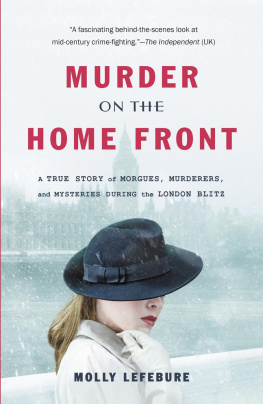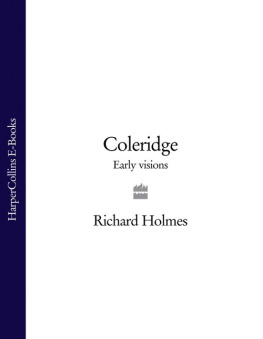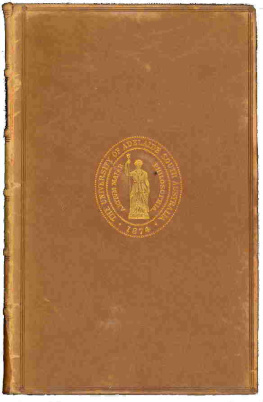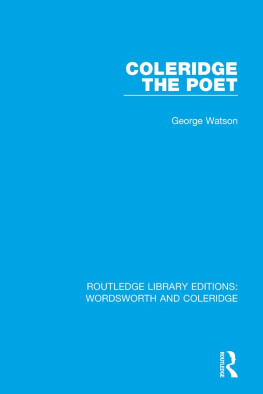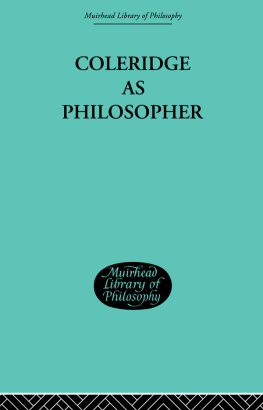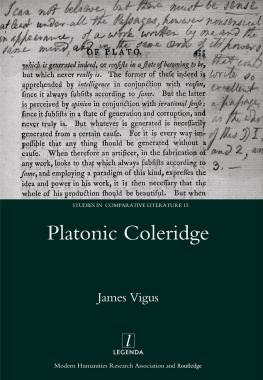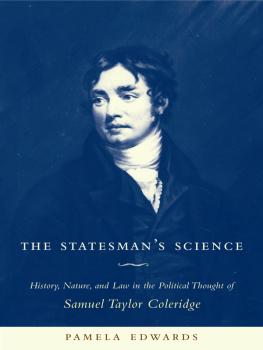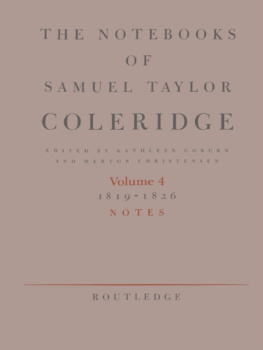Private Lives of the
Ancient Mariner
Coleridge and his Children
Molly Lefebure

The Lutterworth Press
This title is also available in Hardback
ISBN: 978 0 7188 9300 2
and PDF e-book
ISBN: 978 0 7188 4189 8

Foreword
I never met Molly without enjoying it enormously. She had a warmth, an intellectual reach and sometimes a witty asperity which made her extremely good company.
I have always felt that her work, particularly on the Coleridge family, has been absurdly under-rated. As I told her, and as I wrote to her, her insight into Coleridges marriage is second to none. Her perception of him as a man and a poet is intellectually formidable. She can be both critical and understanding on the same page. There is a full field of Coleridge scholars at the moment, but in my view Molly was in there first, and is still the outstanding one.
My only regret is that I did not see her more often. She certainly carved her place in the Newlands Valley as deeply as she wrote her name on the scroll of the great literary biographers.
Melvyn Bragg
Acknowledgements
I began writing A Bondage of Opium , my first biographical work of Coleridge, in 1974. An insatiable zest for investigation, for hunting, for exposing the truth or as near as one can get to it, was planted in me by my forebears and developed and honed by my boss for nearly eight years, Professor Keith Simpson, Home Office Pathologist and head of the Department of Forensic Medicine at Guys Hospital. A keen Sherlockian, he early on insisted that I should impress my memory with that famous rebuke, You see Watson, but you do not observe. Observation was one of the outstanding attributes of this extraordinary man, and he did his utmost to teach me to observe in a similar strain. I have always found research enthralling, and I must confess that for the last thirty-seven years it has rather run away with me when it comes to Samuel Taylor Coleridge.
I always remember Professor Donald Sultana, whose work upon Coleridge in Malta is so invaluable, asking me how I would react if I found STC (as he liked to be called) standing on my doorstep? Would I welcome him in, or slam the door on him? Sultana confessed he had never liked STC very much and would have closed the door on him quick given the chance. As it turned out, he found himself working at length and most importantly upon the poet. I had a terrible feeling that I would hesitate long enough in my decision to give STC a chance to begin to talk; after which of course I should be doomed and find I had him as a house companion for the next decade or so, at the close of which time he would vanish into the night and move in upon another victim with the dire words: There was a ship! and all would be lost. He would begin to tell his tale.
STC first came into my life when I was about nine years old. It was through my aunt, Miss Ada Cox, who dedicated her life to teaching small children, chiefly at the Infants School, Lacock Street, in Islington. She had a genius for arousing enthusiastic interest in youthful minds. Nobody, however difficult, emerged from her classroom without knowing how to read and write.
During a wet and drizzly morning of a summer holiday spent with her on the Bristol Channel, my seven-year-old sister and I found ourselves in our Daniel Neal raincoats, souwesters and gum boots, being marched up a hill, and seated on a park bench at the top, from where we saw the whole of Bath spread out below us. She then took out a paper bag, extracted two buns from it and gave us one each saying: This is a Bath bun and you always eat Bath buns when you come to Bath. She then went on to tell us, while we ate our buns, about a little boy named Robert Southey who lived with his aunt, Miss Elizabeth Tyler, in Bath. She fed him on scraps, dressed him in a green pyjama suit, and took him every night to the theatre to watch Shakespeare. We listened in fascinated horror. He had grown up to become Poet Laureate, lived in Keswick (which we already knew well) and was a great friend of the poet Coleridge, who wrote The Ancient Mariner , a poem to which she was then introducing us. There was a ship!
Steered by an old Navigator with a long grey beard, it sailed into seas of magic water where slimy things transmogrified into beautiful, many-coloured water snakes, happy and joyous. But first: the Navigator took them to the frozen polar water, studded with icebergs green as emerald. As night fell, a white sea-fog glimmeringly enshrouded them. The ships crew assembled on deck for vespers and out of the fog, there came an albatross, yearning for companionship. He perched happily on the rigging and joined the seamen in their prayers. This the bird did nightly until the Navigator, inspired by the evil forever lurking in the human heart, shot the albatross. His fellow seamen, furious with him, hung the dead bird round his neck. This dreadful story, which some may well think unsuited to little girls of tender age, seized me completely. My aunt had got it right. This incredible poem has haunted me ever since, as it has haunted so many.
STC has remained in residence with me, an experience not infrequently close to intolerable. I early began to write about him and learned that a famous Coleridgean in the U.S., hearing of this, had said categorically that no woman would ever be able to write about Coleridge because no woman would ever be able to understand him. What tiddly-pish! Women, as wives, mothers, sisters, know and understand men on quite a different plane from that used by men to observe their fellow men. Coleridge had a close and intelligently observant wife, Sara; an exceptionally articulate and perceptive daughter (also Sara); and a retinue of caustic-tongued females, including the ladies of the Wordsworth household, among them Dorothy Wordsworth and Sarah Hutchinson. Fundamentally STC disliked women. He was an Englishman. Chaps prefer chaps, as P.G. Wodehouse famously remarked. The Ancient Mariner never brought a woman on board.
Of course when I first started to write about him I fell hopelessly in love with him, as all his biographers do. My first biography was about John George Haigh, the so-called Acid Bath murderer. This book was warmly reviewed by Lord Birkett. A year or two later he asked me if I had started a new book and I replied, Yes, I have. Who is it about? he asked. Samuel Taylor Coleridge, I replied. He gave me a sardonic smile. Aha he said, just like me and Spilsbury, you have fallen for the fascination of villainy. I was furious! But, after thirty five years of living with STC I am not sure that Birkett did not have a point. Charles Lamb was right to describe his oldest, truest, friend as an archangel, but an archangel slightly damaged.
I have indeed been privileged to have known and worked with many distinguished Coleridgians, many of whom I first met when I was working with actor Richard Wordsworth, great-great-grandson of William Wordsworth, at his famous and quite inimitable Wordsworth Annual Summer Conference. I cannot begin to try to name all the deeply erudite Coleridgians I met there, and others, not Coleridgians, but renowned in their own field, actors, poets, musicians, authors, dancers, politicians. Michael Foot came every year with great regularity, talking about Hazlitt, equality and freedom, accompanied by his faithful dog, Dizzy (Disraeli), who always rose to his feet in a token salute when, toward the end of the lecture, he heard his masters voice giving the clarion cry of Freedom!
I am gratefully indebted to Professor Thomas McFarland, Murray Professor of English Literature Emeritus at Princeton University, for reading the first draft of this book and for the encouragement he gave me to carry on with the work. I am similarly indebted to Norman Fruman, Professor of English at Minnesota and author of the celebrated Coleridge biography The Damaged Archangel, for reading my second draft with detailed, sometimes astringent, and always helpful criticism, which gave me the impetus to finish this autobiographical study.
Next page

